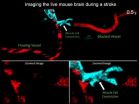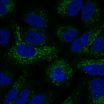(Press-News.org) INDIANAPOLIS -- Indiana University cancer researchers found that a particular microRNA may be a potent therapeutic agent against pancreatic cancer. The research was published June 22 in the journal Scientific Reports.
Led by Janaiah Kota, Ph.D., assistant professor of medical and molecular genetics at the IU School of Medicine and a researcher at the Indiana University Melvin and Bren Simon Cancer Center, the researchers found that restoring missing microRNA-29 (miR-29) in pancreatic cancer stromal cells reduced the viability and growth of the cancerous cells.
A thick fibrotic shell around the cancer cells is known as "stroma," which protects the pancreatic cancer cells from anticancer drugs such as chemotherapy.
"We found that the loss of miR-29 is a common phenomenon of pancreatic cancer stromal cells, and that by restoring it, the stromal accumulation and cancer growth was reduced," Kota said. "The use of miR-29 as a therapeutic agent may be more effective in targeting reactive stroma, as a single miRNA regulates the expression of several genes associated with disease mechanisms."
"In healthy cells and tissues, a single miRNA controls the expression of hundreds of genes, and any alterations in their normal expression leads to abnormal overexpression of bad genes that are favorable for the growth of cancer cells and are harmful to normal cells," Kota explained.
Kota and his colleagues were studying the role of small non-coding RNAs called miRNAs in molecular mechanisms associated with pancreatic cancer stroma to evaluate their use for therapeutic intervention in pancreatic cancer. They found that there is loss of miR-29 in stroma of the pancreatic tumors compared to the healthy pancreas. The researchers expected its expression in stromal cells would restore normal function of stromal cells and reduce the abundance of fibrotic stromal proteins. However, they were surprised that when they co-cultured miR-29 overexpressing stromal cells with cancer cells, it also reduced the viability and growth of cancer cells for unknown factors.
They are currently performing additional studies to understand the molecular mechanisms associated with the effect of miR-29 overexpression in stromal cells on cancer cells as well as in preclinical animal models.
"This is a novel approach that has the potential to overcome the problems associated with current anti-stromal drugs and that could lead to improved therapeutic strategies, enhanced drug delivery to the tumor bed, and, in the future, improved patient survival," said Murray Korc, M.D., the Myles Brand professor of cancer research at the IU School of Medicine and a researcher at the IU Simon Cancer Center. Korc is also director of the Pancreatic Cancer Signature Center.
The need for new therapies for pancreatic cancer patients is great as only 7 percent of people with the disease survive more than five years after diagnosis. According to the National Cancer Institute, there will be an estimated 48,960 new cases of pancreatic cancer and 40,560 deaths from the disease in 2015.
INFORMATION:
The research was supported by the Elsa U. Pardee Foundation and the Pancreatic Cancer Signature Center.
Other IU collaborators included Murray Korc, M.D.; Romil Saxena, M.D.; Grzegorz Nalepa, M.D., Ph.D.; Jesse Gore, Ph.D.; Zhangsheng Yu, Ph.D.; Zahi Abdul-Sater; Ravi Alluri Ph.D.; Smiti Sahu; Sarah Nabinger; and first author Jason Kwon, as well as Zachary Vega of Wabash College.
A new study published in the Articles in Advance section of Transportation Science, a journal of the Institute for Operations Research and the Management Sciences (INFORMS), improves how air traffic managers cope with unexpected delays and provides them with more predictable ways to manage arrival traffic at airports with adverse weather.
The study, Incorporating Predictability into Cost Optimization for Ground Delay Programs, is by Yi Liu and Mark Hansen of the University of California, Berkeley. Ms. Liu received honorable mention for her research in the 2013 INFORMS ...
Scientists from Ludwig-Maximilians-Universitaet (LMU) in Munich and the Max Planck Institute for Quantum Optics can image the optical properties of individual nanoparticles with a novel microscope.
Nanomaterials play an essential role in many areas of daily life. There is thus a large interest to gain detailed knowledge about their optical and electronic properties. Conventional microscopes get beyond their limits when particle size falls to the range of a few 10 nanometers where a single particle provides only a vanishingly small signal. As a consequence, many investigations ...
The American Association for the Study of Liver Diseases (AASLD), in partnership with the Infectious Diseases Society of America (IDSA) and in collaboration with the International Antiviral Society-USA (IAS-USA), created online Recommendations for Testing, Managing, and Treating Hepatitis C in 2014 to aid practitioners treating patients infected with hepatitis C virus (HCV). Now an update to the Guidance, with a summary of recommendations regarding treatment with direct-acting antiviral drugs, is published in the AASLD journal, Hepatology.
HCV is a blood-borne virus ...
(Philadelphia, PA) - In a life-threatening situation, the heart beats faster and harder, invigorated by the fight-or-flight response, which instantaneously prepares a person to react or run. Now, a new study by researchers at Temple University School of Medicine (TUSM) shows that the uptick in heart muscle contractility that occurs under acute stress is driven by a flood of calcium into mitochondria--the cells' energy-producing powerhouses.
Researchers have long known that calcium enters mitochondria in heart muscle cells, but the physiological role of that process was ...
When neurons become active, they call for an extra boost of oxygenated blood -- this change in the presence of blood in different regions of the brain is the basis for functional brain scans. However, what controls this increase or decrease in blood supply has been a long-standing debate.
In a paper published on June 25 in Neuron, Yale University scientists present the strongest evidence yet that smooth muscle cells surrounding blood vessels in the brain are the only cells capable of contracting to control blood vessel diameter and thus regulate blood flow. This basic ...
Think the nest of cables under your desk is bad? Try keeping the trillions of connections crisscrossing your brain organized and free of tangles. A new study coauthored by researchers at UC San Francisco and the Freie Universität Berlin reveals this seemingly intractable job may be simpler than it appears.
The researchers used high-resolution time-lapse imaging of the developing brains of pupal fruit flies (Drosophila melanogaster) paired with mathematical simulations to unravel a trick of neural wiring that had stumped neuroscientists for decades. They discovered ...
Adult fruit flies given a cancer drug live 12% longer than average, according to a UCL-led study researching healthy ageing. The drug targets a specific cellular process that occurs in animals, including humans, delaying the onset of age-related deaths by slowing the ageing process.
The study published today in Cell and funded by the Max Planck Society and Wellcome Trust shows for the first time that a small molecule drug, which limits the effects of a protein called Ras, can delay the ageing process in animals. The treated fruit flies outlived the control group by staying ...
Boston, MA -- A new study led by researchers at Harvard T.H. Chan School of Public Health finds that a malaria parasite protein called calcineurin is essential for parasite invasion into red blood cells. Human calcineurin is already a proven target for drugs treating other illnesses including adult rheumatoid arthritis and lupus, and the new findings suggest that parasite calcineurin should be a focus for the development of new antimalarial drugs.
"Our study has great biological and medical significance, particularly in light of the huge disease burden of malaria," said ...
LA JOLLA--As a tumor grows, its cancerous cells ramp up an energy-harvesting process to support its hasty development. This process, called autophagy, is normally used by a cell to recycle damaged organelles and proteins, but is also co-opted by cancer cells to meet their increased energy and metabolic demands.
Salk Institute and Sanford Burnham Prebys Medical Discovery Institute (SBP) scientists have developed a drug that prevents this process from starting in cancer cells. Published June 25, 2015 in Molecular Cell, the new study identifies a small molecule drug that ...
Washington, DC (June 25, 2015) - Comment sections on websites continue to be an environment for trolls to spew racist opinions. The impact of these hateful words shouldn't have an impact on how one views the news or others, but that may not be the case. A recent study published in the journal Human Communication Research, by researchers at the University of Canterbury, New Zealand, found exposure to prejudiced online comments can increase people's own prejudice, and increase the likelihood that they leave prejudiced comments themselves.
Mark Hsueh, Kumar Yogeeswaran, ...

